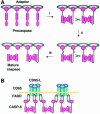Interdimer processing mechanism of procaspase-8 activation
- PMID: 12912912
- PMCID: PMC175803
- DOI: 10.1093/emboj/cdg414
Interdimer processing mechanism of procaspase-8 activation
Abstract
The execution of apoptosis depends on the hierarchical activation of caspases. The initiator procaspases become autoproteolytically activated through a less understood process that is triggered by oligomerization. Procaspase-8, an initiator caspase recruited to death receptors, is activated through two cleavage events that proceed in a defined order to generate the large and small subunits of the mature protease. Here we show that dimerization of procaspase-8 produces enzymatically competent precursors through the stable homophilic interaction of the procaspase-8 protease domain. These dimers are also more susceptible to processing than individual procaspase-8 molecules, which leads to their cross-cleavage. The order of the two interdimer cleavage events is maintained by a sequential accessibility mechanism: the separation of the large and small subunits renders the region between the large subunit and prodomain susceptible to further cleavage. In addition, the activation process involves an alteration in the enzymatic properties of caspase-8; while procaspase-8 molecules specifically process one another, mature caspases only cleave effector caspases. These results reveal the key steps leading to the activation of procaspase-8 by oligomerization.
Figures







Similar articles
-
Interdimer processing and linearity of procaspase-3 activation. A unifying mechanism for the activation of initiator and effector caspases.J Biol Chem. 2005 Mar 25;280(12):11578-82. doi: 10.1074/jbc.M414385200. Epub 2005 Jan 21. J Biol Chem. 2005. PMID: 15664982
-
Oligomerization is a general mechanism for the activation of apoptosis initiator and inflammatory procaspases.J Biol Chem. 2003 May 9;278(19):16466-9. doi: 10.1074/jbc.C300089200. Epub 2003 Mar 13. J Biol Chem. 2003. PMID: 12637514
-
The role of CAP3 in CD95 signaling: new insights into the mechanism of procaspase-8 activation.Cell Death Differ. 2006 Mar;13(3):489-98. doi: 10.1038/sj.cdd.4401766. Cell Death Differ. 2006. PMID: 16179941
-
Caspase activation: revisiting the induced proximity model.Cell. 2004 Jun 25;117(7):855-8. doi: 10.1016/j.cell.2004.06.007. Cell. 2004. PMID: 15210107 Review.
-
Structure and zymogen activation of caspases.Biophys Chem. 2002 Dec 10;101-102:145-53. doi: 10.1016/s0301-4622(02)00151-5. Biophys Chem. 2002. PMID: 12487996 Review.
Cited by
-
Death effector domain DEDa, a self-cleaved product of caspase-8/Mch5, translocates to the nucleus by binding to ERK1/2 and upregulates procaspase-8 expression via a p53-dependent mechanism.EMBO J. 2007 Feb 21;26(4):1068-80. doi: 10.1038/sj.emboj.7601571. Epub 2007 Feb 8. EMBO J. 2007. PMID: 17290218 Free PMC article.
-
Clustering of the neural cell adhesion molecule (NCAM) at the neuronal cell surface induces caspase-8- and -3-dependent changes of the spectrin meshwork required for NCAM-mediated neurite outgrowth.J Biol Chem. 2010 Dec 31;285(53):42046-57. doi: 10.1074/jbc.M110.177147. Epub 2010 Oct 20. J Biol Chem. 2010. PMID: 20961848 Free PMC article.
-
Recent advances in 2D and 3D in vitro systems using primary hepatocytes, alternative hepatocyte sources and non-parenchymal liver cells and their use in investigating mechanisms of hepatotoxicity, cell signaling and ADME.Arch Toxicol. 2013 Aug;87(8):1315-530. doi: 10.1007/s00204-013-1078-5. Epub 2013 Aug 23. Arch Toxicol. 2013. PMID: 23974980 Free PMC article. Review.
-
The HECTD3 E3 ubiquitin ligase facilitates cancer cell survival by promoting K63-linked polyubiquitination of caspase-8.Cell Death Dis. 2013 Nov 28;4(11):e935. doi: 10.1038/cddis.2013.464. Cell Death Dis. 2013. PMID: 24287696 Free PMC article.
-
Cell death controlling complexes and their potential therapeutic role.Cell Mol Life Sci. 2015 Feb;72(3):505-517. doi: 10.1007/s00018-014-1757-2. Epub 2014 Oct 17. Cell Mol Life Sci. 2015. PMID: 25323133 Free PMC article. Review.
References
-
- Ashkenazi A. and Dixit,V.M. (1998) Death receptors: signaling and modulation. Science, 281, 1305–1308. - PubMed
-
- Blanchard H., Donepudi,M., Tschopp,M., Kodandapani,L., Wu,J.C. and Grutter,M.G. (2000) Caspase-8 specificity probed at subsite S(4): crystal structure of the caspase-8-Z-DEVD-CHO complex. J. Mol. Biol., 302, 9–16. - PubMed
-
- Boatright K.M. et al. (2003) A unified model for apical caspase activation. Mol. Cell, 11, 529–541. - PubMed
-
- Chang D.W. and Yang,X. (2003) Activation of procaspases by FK506 binding protein-mediated oligomerization. Sci. STKE, 2003, PL1. - PubMed
Publication types
MeSH terms
Substances
Grants and funding
LinkOut - more resources
Full Text Sources
Molecular Biology Databases
Miscellaneous

